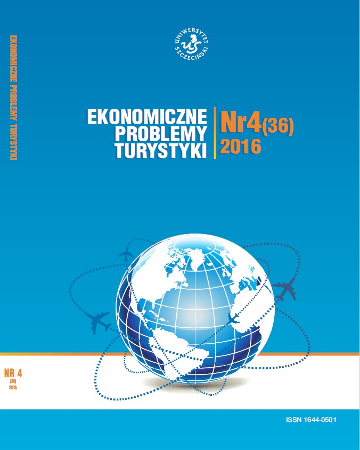
ISSN: 1644-0501
eISSN: 2353-3188
OAI
DOI: 10.18276/ept.2018.2.42-05



Issue archive /
nr 2 (42) 2018
Preferencje turystów z Chin dotyczące wyboru atrakcji odwiedzanych w Europie
(Preferences of Chinese tourists towards the choice of attractions in Europe)
| Authors: |
Czesław
Adamiak
Uniwersytet Mikołaja Kopernika w Toruniu Wydział Nauk o Ziemi Barbara Szyda Uniwersytet Mikołaja Kopernika w Toruniu Wydział Nauk o Ziemi Anna Dubownik Uniwersytet Mikołaja Kopernika w Toruniu Wydział Nauk o Ziemi |
| Keywords: | Chinese tourists Europe tourist preferences tourism attractions TripAdvisor |
| Data publikacji całości: | 2018-06-20 |
| Page range: | 10 (49-58) |
| Klasyfikacja JEL: | L83 Z30 |
Abstract
The aim of the study is to learn the preferences of Chinese tourists in Europe in terms of the choice of tourist attractions which they visit. The article uses an original research procedure: for selected tourist attractions in European countries the numbers of reviews posted on TripAdvisor webpage in general and in Chinese are measured. This allows to determine which attractions in the countries in analysis are most visited by Chinese tourists, and which countries and what kinds of attractions are most popular among Chinese visitors. The results show that Chinese tourists are primarily focused on the most popular urban tourist destinations in Europe, and online reviews can be a valuable source of information on travel preferences of groups of tourists.
Download file
Article file
Bibliography
| 1. | Adamiak, C., Dubownik, A. (2017). Opinie online o parkach narodowych w Polsce. Studia i Materiały CEPL w Rogowie, 19 (52/3), 18-25. |
| 2. | Buhalis, D. (2003). eTourism: Information technology for strategic tourism management. London: Pearson. |
| 3. | Chinavia (2013). Survey of Chinese visitors to Scandinavia: Perspectives for Scandinavian city tourism. Copenhagen: Wonderful Copenhagen Research & Development. |
| 4. | Croce, V. (2016). Tourism in Focus: The Chinese Outbound Travel Market. Virtual Tourism Observatory. Brussels: European Commission. Pobrano z: https://ecty2018.org/wp-content/uploads/2017/08/EC-2016-The-Chinese- Outbound-Travel-Market.pdf (17.01.2018). |
| 5. | European Travel Commission (2017). European tourism in 2017: trends & prospects, Quarterly Report (Q2/2017). GUS (2017). Turystyka w 2016 r. Warszawa: Główny Urząd Statystyczny. |
| 6. | Li, X., Harrill, R., Uysal, M., Burnett, T., Zhan, X. (2010). Estimating the size of the Chinese outbound travel market: A demand-side approach. Tourism Management, 2 (31), 250-259. |
| 7. | MacCannell, D. (2002). Turysta. Nowa teoria klasy próżniaczej. Warszawa: Wydawnictwo Muza. |
| 8. | Marine-Roig, E. (2017). Measuring Destination Image through Travel Reviews in Search Engines. Sustainability, 9 (1425). |
| 9. | O’Reilly, T. (2005). What Is Web 2.0. Pobrano z http://oreilly.com/web2/archive/what-is-web-20.html (17.01.2018). POT (2017). Analiza rynków za rok 2016 objętych działaniami zagranicznych ośrodków Polskiej Organizacji Turystycznej (ZOPOT). Trendy, wizerunek Polski, produkty, komercjalizacja. Pobrano z: https://www.pot.gov.pl/ component/rubberdoc/doc/5948/raw (17.01.2018). |
| 10. | Stokłosa, Ł., Marchiori, E., Piotrowski, M., Cantoni, L. (2013). Wykorzystanie modelu Destination Online Reputation do oceny obszaru recepcji turystycznej. Studium na przykładzie województwa podkarpackiego. Folia Turistica, 25, 129-148. |
| 11. | Travel China Guide (2016). China Outbound Tourism in 2016. Pobrano z: https://www.travelchinaguide.com/touri- sm/2016statistics/outbound.htm (30.11.2017). |
| 12. | UNWTO (2013). Tourism Highlights 2013 Edition. Pobrano z: https://www.e-unwto.org/doi/pdf/10.18111/9789284415427 |
| 13. | (17.01.2018) . |
| 14. | UNWTO (2016). UNWTO/GTERC Asia Tourism Trends 2016 Edition. Pobrano z: http://cf.cdn.unwto.org/sites/all/files/ pdfZunwtogterc_annual_report_on_asia_tourism_trends_-_2016_edition_executive_summary.pdf (1701.2018). UNWTO (2017a).Tourism Highlights 2017 Edition. Pobrano z: https://www.e-unwto.org/doi/pdf/10.18111/9789284419029 |
| 15. | UNWTO (2017b). World Tourism Barometer, Volume 15. Pobrano z: http://cf.cdn.unwto.org/sites/all/files/pdf/unw- to_barom17_06_december_excerpt_.pdf (17.01.2018). |